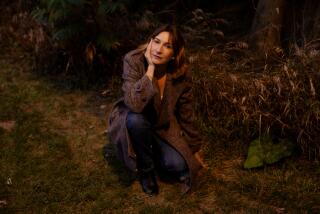Below the Surface : Carol...
- Share via
The two brief, wonderful novels that make up “Happenstance” were written in the late 1970s but not brought out in the U.S. until now, in a two-for-one/his-and-hers paperback package. If you are unfamiliar with the work of American-born Canadian novelist Carol Shields, this set is a splendid place to start.
Her most recent novel, “The Stone Diaries,” which was short-listed last summer for the Booker Prize, is being published at the same time. In between, she wrote “Swann” (1989) and “The Republic of Love” (1992).
I doubt that many hostesses would choose Chicago suburbanites Brenda and Jack Bowman, the his-and-her of “Happenstance,” to transform their dinner parties into a latter-day Algonquin Round Table, but in Carol Shields’ gifted hands, their ordinary lives are hugely engrossing and sharply, satirically fixed at the edges of the social and intellectual trends of the late 1970s, though there is nothing dated about the material.
The novels tell the story of housewife-turned-quilt-maker Brenda’s five-day trip to a crafts convention in Philadelphia, from her point of view and, when you flip the book over, from her husband Jack’s. At 40, Brenda has not been touched by “the new sexual freedom” and hasn’t taken a trip on her own in 20 years of marriage. Jack, who will for the first time stay home with their two teen-age children, is a second-rate historian who works at a think tank and has been lethargically writing a history of Indian trading practices for many years.
The novels’ his-and-her format will bring to mind Evan Connell’s “Mrs. Bridge” and “Mr. Bridge,” but Brenda and Jack are a different breed--contemporary suburbanites with an above-average sex life, a sense of humor and history, and a profound gratitude that their children are not drug addicts. Unlike the Bridges, Brenda and Jack are deliciously, delightfully introspective, especially for these five days when their roles are so dramatically reversed.
Separation forces them to master life skills they’ve never had to use (Jack changes a typewriter ribbon for the first time; Brenda flirts with infidelity), but beneath the surface challenge, both are preoccupied with whether they have lived as fully as they meant to, whether they have made enough of their lives, a subject that animates many of Carol Shields’ characters. When she got married in the late 1950s, Brenda wanted nothing more than a pink kitchen and Armstrong flooring, but now, “there was a reluctance . . . to say: well, that’s the way it is. When she looked at something these days--a face, a house, an expanse of scenery--she was more likely to think, is this all there is?”
When Jack’s only friend Bernie is abandoned by his wife and comes to him for comfort, Jack is not really up to the job. “A better man--where was he?--would give his full attention and sympathy to his oldest friend, his friend who has today suffered a major catastrophe in his life, who is feeling lost and alone and frightened and even tearful.” Instead, Jack drags him to a cocktail party.
Shields is wickedly accurate about the intricacies of marriage, parenthood and the battle of the sexes, and an astute observer and satirist of social trends. One of the great pleasures of “Happenstance” is the way she manages to turn a crafts convention into a bed-swapping Feydeau farce with feminist overtones and a very moving outcome.
There is something wonderfully illicit about this pair of books, because we’re privy to so much about Brenda and Jack’s lives they will never tell each other, the big secrets and the small, like this one: “Once, years ago, when she was painting her bedroom, she stood on a stepladder and saw carved into the molding over the door frame the words ‘Jake Parker, builder, 1923.’ She thought of telling Jack about it, but never did. He would overprize it, lead friends upstairs to see it. She kept it to herself: Jake Parker, young, muscular, audacious.”
In “The Stone Diaries,” a luminous, wonderfully ambitious novel, Shields is also driven by the unbearable lightness of living an ordinary life. The “diary” is Daisy Goodwill Fletts’ brilliantly inventive account of her 80-plus years, told in the first person, the third person, photographs, letters, menus and a family tree, whose most glaring omission involves Daisy’s mother, Mercy Stone, who died in childbirth. Not even the names of Mercy’s parents are known, and this huge absence--of a mother, of antecedents--makes Daisy feel throughout her life “that she belongs to no one,” that she has spent her many years “hurling herself at the emptiness she was handed at birth.” Yet Daisy takes care to remind us that “she is not always reliable when it comes to the details of her life; much of what she has to say is speculative, exaggerated, wildly unlikely.”
Born unexpectedly in Manitoba in 1905--her obese mother hadn’t known she was pregnant--Daisy spends her final days in a Florida nursing home in the 1990s, rewriting her life and imagining the judgments her children will pass on her once she’s gone. Looking back over her motherless childhood, her reunion with her stonecutter father at age 11, her two marriages and three children, she knows her only genuine fulfillment has come from writing a much-loved gardening column for a local newspaper in her late 50s, only to be abruptly fired when a burned-out news reporter (male) wanted a change of pace and laid claim to her job.
Soon after, she falls into a deep depression and, as is typical in the diary, gives everyone in her life an imaginary chance to theorize about why. Best friend Fraidy concludes that she’s sexually frustrated. Her son says she “must be in mourning for the squandering of her life,” and her career-woman daughter is certain it’s because she lost her job. Brilliant ventriloquist that Shields is, we forget for pages at a time that Daisy is the only narrator of this tale; every utterance, every hard-edged interpretations, has her name on it.
“The Stone Diaries” has the scope of a Dickens novel, the wit of Muriel Spark and the stylistic inventiveness of Graham Swift’s “Waterland.” The cast of characters is large, rowdy, and lovable; all are sharply rooted in their own time and place.
Daisy is obsessed with what she feels is her insubstantiality, the fact that she has spent her life “moving right along, and along, and along. . . . Numbly, without thinking.” Yet she was born of stone: her mother’s maiden name was Stone; her father and father-in-law were both stonecutters. Her greatest glory may have been her gardening column--flowers being beautiful but evanescent, the opposite of stone--but the novel Shields has fashioned from her extraordinary ordinary life has the strength and iridescent beauty of a diamond.
More to Read
Sign up for our Book Club newsletter
Get the latest news, events and more from the Los Angeles Times Book Club, and help us get L.A. reading and talking.
You may occasionally receive promotional content from the Los Angeles Times.







